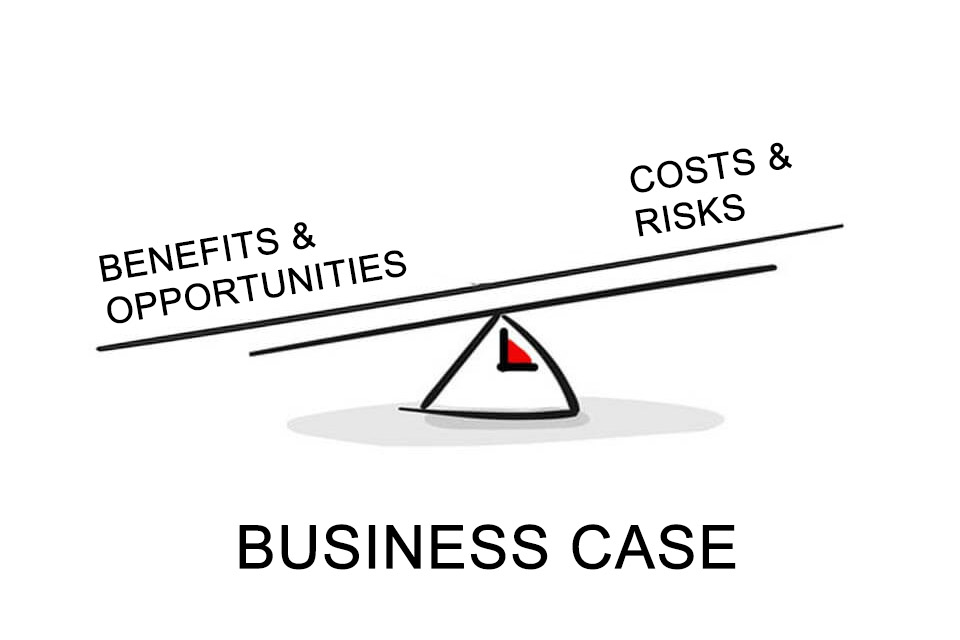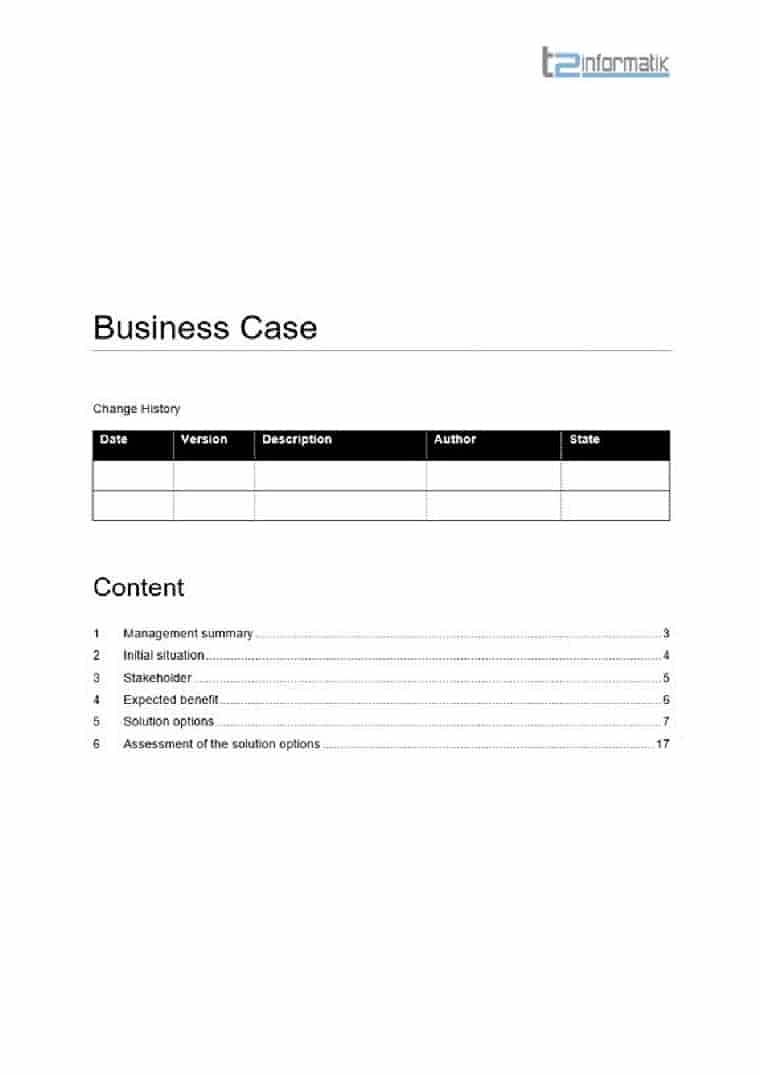What is a Business Case?
Smartpedia: A business case assesses the impact of investments and is the basis for the approval or ongoing justification of projects.
Business Case definition
In a Business Case, the possible financial and strategic effects of a company’s investment in a project, a product development or a market expansion are presented and assessed. The assessment is made by comparing different options for action on the basis of a profitability analysis.
However, the Business Case analysis does not only include monetary aspects – such as the possibility of reducing costs, increasing sales or increasing market share – but also non-monetary aspects such as possible risks, an expected benefit or the feasibility of the project.
Put simply, a Business Case assesses whether a project, a venture or an enterprise is worthwhile. Essentially, it answers the following questions:
- Why should a project be carried out and what happens if nothing is done and the status quo is maintained?
- What is the best alternative to implementing the project?
- What are the economic and/or strategic benefits of the project?
- How long does the project take and in what time period will an economic and/or strategic benefit be realised?
- What risks does the project entail and what costs can be predicted?
And last but not least what contribution does the project make to achieving strategic goals?
Business Case as a term
A Business Case is a term used in accounting to describe a situation in which money related to a company’s purpose is used as revenue or expenditure. Synonyms such as cost-benefit analysis or investment calculation do not apply, because they are rather part of a Business Case. Business plan or business model also have a different meaning. Even the term business scenario, which deals with the development of solutions, the definition of value chains, the handling of risks, market potentials and competitors, is not exactly accurate. Business case has therefore established itself as a term.
The meaning of Business Cases
Very often decisions in companies are made on the basis of economic considerations. The Business Case is an important instrument here, because it assesses which projects are preferable to others and who wins the internal competition for resources, manpower and financial resources. It also assesses how best to proceed in the implementation of a project, in the implementation of a project proposal. Thus, the sense of a business case lies both in a consideration of effectiveness (“doing the right things”) and efficiency (“doing the things right”). In practice, this leads to two possible investment situations addressed by a Business Case: a single investment or a comparison of alternatives for prioritisation, of which several can be lucrative and yet only the most lucrative is implemented.
If the predicted costs exceed the expected benefits, the implementation of a project is not worthwhile. The effort to create the Business Case, however, was not in vain, because it avoids x times higher efforts without meaningful countervalue. Even a negative profitability assessment can result in two basically positive options:
- If the project is classified as “promising”, a reassessment after the implementation of individual other projects could lead to later implementation.
- If the project is classified as “strategic”, it could nevertheless be implemented in order, for example, to create a technological basis for further projects or to enable entry into new markets.
Business Case analysis
A Business Case arises in the course of an analysis. In itself, it is merely the result of a research. Why should a project be carried out? Why should project A be carried out earlier than project B? If project A is implemented, how should this be done? What are the risks involved in implementing project A? And what actually happens if no project is implemented? These are questions that need to be answered in the context of Business Case analysis.
A Business Case can be based on different sources:
- case studies of similar projects in your own organisation or in the industry
- surveys, studies or customer opinions
- existing or new risk assessments
- calculations of investments, returns and/or financial resources
- previous business cases of comparable projects
The business case analysis provides a proposal for the implementation of a project. Once an initial implementation decision has been made, the business case must be compared with reality at defined points in time – often referred to as quality gates – and adjusted if necessary. This can lead to a new assessment or even to the termination of the project.
Key figures in the Business Case
Projects differ in effort and duration, in opportunities and risks, in benefits and effects. A comparison is not always easy to make. A comparison is made more difficult when strategic aspects are added. For some years now, there have been different market participants who no longer focus on sales and profits in the traditional sense, but rather on awareness, reach and market share. Only in the medium or long term should these aspects lead to profits. This also has an impact on the assessment of Business Cases.
Key figures can be used to compare projects or alternatives. There are various ways of generating key figures:
- By calculating the internal rate of return, you can compare projects of different sizes.
- The net present value method supports the comparison of similar projects – for example, when selecting a suitable alternative to implementing a project – by discounting forecast cash flows over time.
- The Economic Value Added (EVA) procedure assesses the increase in value that ideally arises for the company as a result of the project.
- The risk evaluation includes, for example, the GAMAB principle for comparing risks or the ALARP principle for risk reduction.
In practice, the combination of different methods can often be observed.
Advantages of Business Cases
Working with business cases offers a number of advantages:
- the decision certainty is increased, because possible effects of a project are pointed out.
- the scope for decision-making is increased, as various alternatives for implementation are assessed.
- transparency is increased because all monetary and non-monetary facts are consolidated.
- traceability is guaranteed, because the derivation of key figures creates clarity.
- comparability is ensured because different projects or alternatives are compared.
- controlling is facilitated during the implementation of the projects, because the assumptions made can be easily compared with reality.
- risk management is improved because possible risks and corresponding countermeasures are focused on at an early stage.
- The commitment increases, because the reasons that lead to a decision are documented.
Breakdown of a Business Case
A business case is usually divided into the following chapters:
- Summary: short management overview
- Reasons: Motivation for implementing the project
- Options: Description of the possibilities for implementing the project
- Benefit: List of benefit advantages with qualitative and quantitative evaluation
- Negative effects: Description of possible negative effects and disadvantages
- Risks: Description of the biggest risks with corresponding measures
- Time frame: Implementation time for the project and also for return on investment
- Costs: project costs during implementation and after commissioning
- Investment calculation: information on the return on investment (ROI); cost-benefit analysis, profitability analysis
In addition, the description of purpose and scope, the use of a title, the naming of the author, as well as the use of version numbers is recommended.
The Business Case as Ongoing Justification
Creating a Business Case is more difficult than it might seem. The difficulty increases with the complexity of the project. Usually it is not enough to fill out a simple template, because methodical knowledge for the calculation of the key figures and a portion of experience are in demand particularly with the calculation of the economy, with the view of costs and benefits and with the calculation of financing possibilities.
In practice, it has proved successful to divide costs into one-off costs and periodic costs, whereby the degree of detail can be determined depending on the scope, duration and fundamental importance of the project. A corresponding structure is also recommended for the analysis of the benefits. Even risks, conceivable side effects and possible measures should be classified.
If a decision is positive after the analysis, it makes sense to use the Business Case as an orientation for the project or the development. The PRINCE2 project management method defines, for example, the use of quality gates, i.e. it specifies that the Business Case must be checked for its topicality at defined milestones. In the case of changed framework conditions, new findings from development or new requirements from stakeholders, this can result in either the adaptation of the agreed Business Case or even the termination of the project. Ideally, the assumptions and orientation of the Business Case are confirmed and the project continues as planned.
Business Case Template
When defining a Business Case, it is a good idea to work with a template. This allows the creator to concentrate on the content and less worry about the structure and outline. Some templates are kept short and are therefore also called One Pagers – the goal is a short description of the project with its profitability on one page if possible. This can make sense with a relative view, i.e. with the representation of differences of individual action options, e.g. with extensions of existing solutions – the core of the solution is accordingly known and less important data are not raised.
In absolute terms, however, it is advisable to use a template that includes all benefit arguments, possible risks and side effects, various options and, above all, the investment calculation. The investment calculation leads to key figures and the key figures enable a quantitative comparison. This cannot be shown comprehensibly on a single page. Here, the use of a comprehensive business case template is the best solution.
Download the Business Case Template now for free.
With the business case template you describe the following aspects:
- the initial situation, the stakeholders and the expected benefits
- the different solution options including framework conditions, use cases, risks, costs, deadlines and economic efficiency
- the assessment of the solution options
Template for simple and fast documentation of business cases.
Is it useful to use a Business Case in agile projects or developments?
Notes:
If you like the article or would like to discuss it, please feel free to share it in your network. And if you have any comments, please do not hesitate to send us a message.
Here you can find additional information from our t2informatik Blog:





